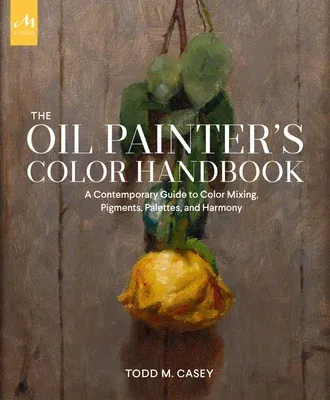A contemporary and accessible foundation of color theory and advanced
techniques for the oil painter at every skill level
"In The Oil Painter's Color Handbook, Todd Casey presents priceless
information that every art school should teach and every art student
should learn. The book breaks down the subject of color into useful
pieces of knowledge that painters can put into practice. He analyzes
color in terms of light, value, pigment, mixing strategies, palette
arrangements, and painting techniques. Each topic is clearly and
succinctly explained in the text, illustrated with captions, charts,
diagrams, and finished paintings. By the end of the book, the reader
will have a clear understanding of how realist painters and illustrators
have used color through history." - James Gurney, artist and author
"This is the most impressive and complete book on color ever produced.
It covers a wide range of color concepts, including some I'd never seen
before. It digs deeply into color harmony, techniques, and has powerful
examples to demonstrate every concept." - Eric Rhoads, Publisher, Fine
Art Connoisseur Magazine
From Todd M. Casey, acclaimed artist and expert teacher, The Oil
Painter's Color Handbook: A Contemporary Guide to color Mixing,
Pigments, Palettes, and Harmony provides everything the oil painter
needs to understand all aspects of color and empowers the reader to
paint with confidence. As Casey notes, every artist and
artist-in-training must learn how to "master the main concepts of
picture-making: drawing, light, shadow, value, form, composition, and
color."
A follow-up to the bestselling The Art of Still Life: A Contemporary
Guide to Classical Techniques, Composition, and Painting in Oil
(Monacelli, 2020), The Oil Painter's Color Handbook begins with an
in-depth look at the use of color throughout art history. Casey then
breaks down the process of understanding color into easily digestible
lessons--each clearly explained and richly illustrated with both
historic and contemporary paintings--so that the reader can learn
progressively and layer more complex ideas as each skill is achieved.
Through clear instruction, step-by-step demonstrations, and challenging
exercises, readers will learn to apply these techniques and concepts to
their own painting. Once educated with this fundamental knowledge, as an
artist, one can begin to find the balance between the science and
emotional intuition in creating art. This informative and visually
dynamic book will be accessible and appealing to artists, art students,
and art instructors, to serious amateurs and hobbyists.

